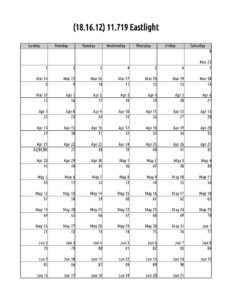 I discovered an error that I made in calculating when the leap years occur. I thought this year, 11.719, was itself a leap year, but it turns out I had the leap years wrong. 11.717 was a leap year and 11.721 will be one, too.
I discovered an error that I made in calculating when the leap years occur. I thought this year, 11.719, was itself a leap year, but it turns out I had the leap years wrong. 11.717 was a leap year and 11.721 will be one, too.
I’m not sure how I made the error but I discovered it when calculating the likely leap years going into the future. As such, it was necessary for me to change the calendar for this year, 11.719. I had it down as starting on December 21, 2018, but it actually began one day later on December 22. Eastlight also started one day later.
However, the fact that this isn’t a leap year means that Eastlight has only 91 days instead of 92. This is because the leap day is currently added to the end of Eastlight if this is a leap year. By beginning the first day of the year one day later and removing the leap day from the end of Eastlight, the calendar actually “catches up” with itself by Northlight 0.
In the Earth Epic Calendar, the New Year is based on the actual time of the December Solstice. To be precise, the New Year begins at the midnight closest to the time of the solstice according to Coordinated Universal Time (UTC). If the solstice falls before the stroke of noon in the UTC time zone, the New Year begins that previous midnight–if it falls after that stroke of noon, then the new year begins the following midnight.
Most of the time, 365 days elapse between the two New Years on the calendar, but occasionally, 366 days elapse, which makes the year a leap year. The Gregorian calendar has a formula for determining the year–every four years except for years ending in “00” that are not divisible by 400. (Thus, 2000 CE was a leap year, but 1900 wasn’t and neither will 2100).
On one level, determining the day of the New Year in the Earth Epic Calendar is very simple, but it requires knowing the precise time of the December Solstice. Modern astronomy has been able to predict the precise time going several hundred years into the future. But the further in the future or the past the prediction is made, the less accurate it will be. To some extent, it’s due to the unpredictability of the Earth’s rotation. A discussion on this topic is here.
This challenge is also shared by both the Solar Hirji calendar and the Baha’i calendar (the latter starting only in 2015 CE), both of which have their new years tied to the spring equinox in the Northern Hemisphere. So, while the Gregorian calendar bases its leap years on a simple mathematical formula, such a simple formula isn’t availalbe for the Solar Hijri, Baha’i, and Earth Epic calendars. Attempts have certainly been made, but nevertheless, a formula has proven elusive.
I calculated the dates of the New Year from a database developed by Barry Carter that I downloaded from GitHub. He has acknowledged its limitations in the discussion I previously referenced. I’ve made the corrections on the downloadable calendar and the Google/iCal file that you can link to your own smartphone calendar. I have also added a list of leap years on this website for between 11.283 and 12.000 EE (1582-2300 CE). The year 1582 CE is the year the Gregorian Calendar was first implemented.
Analyzing the data, most leap years occur every four years, but once every 33 or 37 years, an interval of five years occurs. In looking at the years between 11.283 and 12.000 EE, the pattern of 33 and 37 years isn’t fully predictable. Sometimes the 33 and 37 year cycles alternate, and sometimes two 33 year cycles will occur before alternating with a 37 year cycle. The original data base dates from 13,201 BCE to 17,091 CE, so theoretically, I could put together a database for the entirety of Epoch 12, which runs from 9,701 BCE to 15,299 CE. But in looking at the data, I can see how the dates for the December Solstice drift several months, which shows the limitations of the Gregorian calendar.